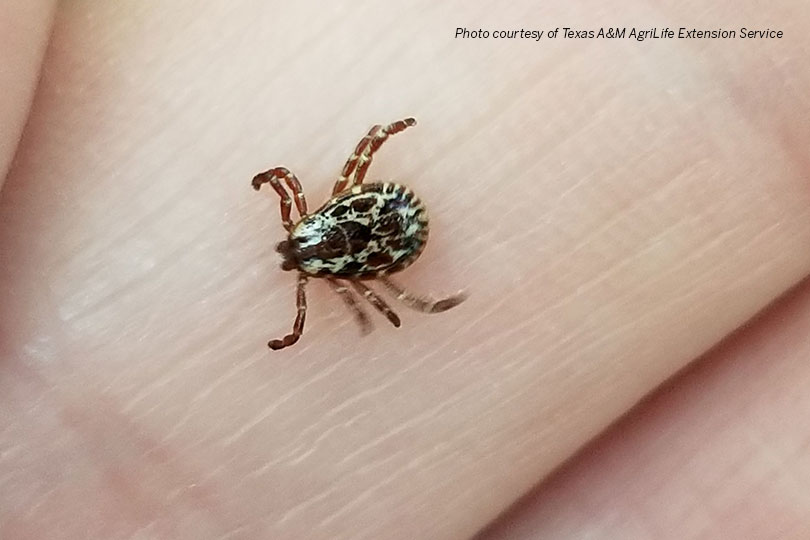By Jennifer Dorsett
Field Editor
Summer holds the promise of outdoor adventures, but Texas A&M AgriLife Extension Service experts say the danger represented by ticks increases during this time of year, as well.
“Ticks are blood feeders in all life stages and can transmit pathogens that can lead to disease transmission,” Sonja Swiger, Ph.D., AgriLife Extension Service livestock and veterinary entomologist at Stephenville, said. “While we do see tick-borne disease here in Texas, our rates are much lower than many other states. However, people need to be aware and vigilant. That is the only way to stop them.”
Location, location, location
Ticks do not fly. So, to be exposed, people or animals must enter an area where ticks exist or come into contact with other warm-blooded animals carrying the parasites.
While they’re mainly found outdoors, ticks can be transported on people or domestic animals into homes, barns and other spaces where people and animals live.
“Aside from if you’re in a concrete jungle, there can be ticks,” Swiger said. “They can be in overgrown brush, a field, forest, park, tall grasses and anywhere there is wildlife.”
In some parts of the state, ticks seem to disappear in colder months, while in other parts of Texas it’s a year-round battle. According to Swiger, now is the start of their “plentiful season.”
Life cycle
Ticks are parasitic, blood-feeding arthropods closely related to mites, spiders and scorpions, according to the AgriLife Extension Service TickApp. The life cycles of ticks consist of four stages: egg, six-legged larva, eight-legged nymph and adult.
Ticks commonly require three separate hosts–one each for the larval, nymphal and adult life stages. The immature larval and nymphal stages generally feed on a variety of animal classes, including numerous bird or small mammal species, while adult ticks tend to use larger animals such as deer, cattle and horses.
After biting the host and ingesting its blood, the blood-meal nutrients are digested by ticks for fuel to molt to the next stage or to produce eggs for the next generation.
Through their salivary glands, they “pump” excess body water back into their host. It is through this process of gut-water expulsion that ticks can transmit bacterial, rickettsial, protozoal, viral and fungal pathogens to animal and human hosts.
There are 11 common species of ticks found in Texas.
Humans and pets are most likely to come into contact with the black-legged tick, brown dog tick, Lone Star tick, Gulf Coast tick and American dog tick, while livestock frequently are exposed to Gulf Coast ticks, spinose ear ticks and cattle fever ticks.
Disease transmission
Lyme disease is the most common vector-borne disease in the U.S., but Rocky Mountain spotted fever, tularemia and other diseases can also be transmitted from ticks to humans. An average of 30,000 cases of Lyme disease are reported annually to the Centers for Disease Control and Prevention.
According to the American Kennel Club, ticks may transmit a variety of serious diseases to pets, including Lyme disease, ehrlichiosis, anaplasmosis, Rocky Mountain Spotted Fever, babesiosis, bartonellosis and hepatozoonosis.
The parasite can cause harm to domestic livestock and wildlife due to the blood loss that can occur when large numbers of ticks feed on an animal. AgriLife Extension specialists say secondary infections can occur at the feeding sites, diminishing the value of livestock from the damage to hides. Ticks are also responsible for often-deadly diseases in livestock such as bovine babesiosis, or cattle fever.
Cattle fever is a severe disease beginning with the development of a high fever and cessation of feeding, or going “off feed,” followed by dehydration. As the disease progresses, animals become lethargic and will eventually lapse into a coma and sometimes die. In naïve infected cattle, or those that have not been ex-posed to the disease before, 70 to 90 percent will succumb to the disease.
Prevention
Ticks will attempt to latch on to people’s heads, hair, chest, armpits, groin, waists and back of the knees. Hats, long-sleeved shirts and pants in light colors offer some protection from pests finding their way onto skin. Swiger advises tucking pants into boots, as well.
“Check yourself after being outdoors,” she said. “Also, check your pets if they have been outdoors.”
Around the house, keep grass mowed and bushes trimmed. Since rodents are part of the tick-borne disease cycle, eliminate places they may live or hide.
There are numerous products available for flea and tick control in pets. Check with a veterinarian for the most appropriate product for your pet and location.
In livestock, various acaricides are used in pour-ons, dip vats, dusts and other formulations. Veterinarians can advise livestock owners of the best product and method for control.
If a tick is found, Swiger said it can be removed with tweezers. Grasp the tick as close to the head as possible and pull straight out.
If the head breaks off under the skin and cannot be removed, or if any pain, lesion or a rash develops, contact a doctor. If fever, headache, joint pain, muscle pain or swollen lymph nodes occur within 30 days of a tick bite, inform a doctor immediately.

